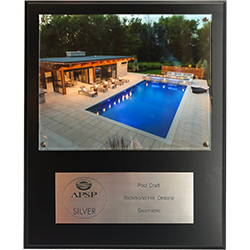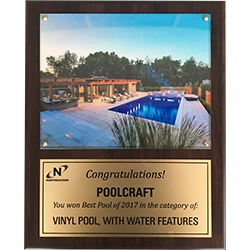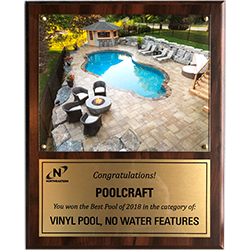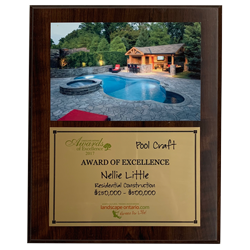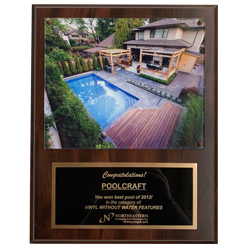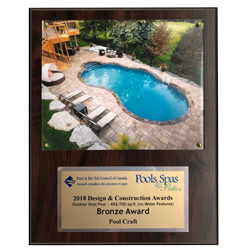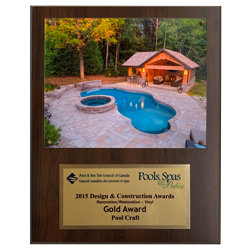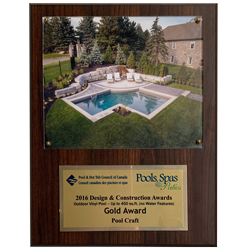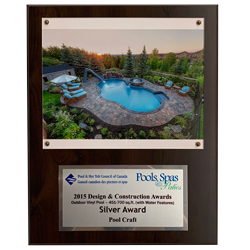Here in Ontario, pool owners don’t really have the luxury of deciding whether or not to buy a winter pool cover – the elements make that decision for us! If you want to make sure your backyard swimming pool is useable come next summer, you’re going to need to invest in a sturdy and reliable winter pool cover.
As the swimming season draws to an end, it’s important to plan ahead so that you can winterize and close your pool to keep it safe for when the snow and ice sweep in with a vengeance. Winter debris can quickly damage the vinyl lining or otherwise make a giant mess that will be no fun to clean up in the spring.
It may be tempting to think that all pool covers are alike and to simply buy the first one that is the right size and shape, but taking a bit of time in advance to learn about swimming pool covers can save you a lot of frustration down the road.
 Types of Winter Pool Covers
Types of Winter Pool Covers
For inground pool covers, you have a tarp-style cover secured with water tubes or water bags to hold them in place.
There are also mesh style covers called Safety Covers which use brass anchors, which sit flush with the patio.
The third type of winter cover is the Fitted or Lock-in style which fits into pool coping track. For the lock-in style covers, pool must have a double track coping typically for vinyl pools only.
When it comes to the type of material, you’ll have your choice between a variety of mesh covers, a heavier tarp style cover or a solid safety or auto cover.
Mesh Safety Covers
These covers are lighter and easier to maneuver, which can save you time when you are installing or removing your cover. They are the more popular cover amongst consumers these days because of the safety features and ease of removal. These covers are installed using grommets that spin down and sit flush with the deck during the season and sit up out of the deck to hold the cover in place once installed.
The drawback is that the mesh materials are more prone to allow fine debris through the cover over the winter causing a more thorough clean up in the spring. The upside to this cover is it can withstand the weight of an elephant without sinking or coming loose. This is great for families with pets or children to ensure no one can fall onto the cover and get stuck. It is secured tightly around the pool which creates almost a trampoline effect for ultimate safety.
With proper care, a decent quality safety cover typically lasts 10-15 years. Minor repairs may be needed over the course of the cover’s lifespan.
Tarp Covers (water bag or fitted)
These are the most common type of covers you would see on a pool in these parts and come in 2 styles. The tarp cover can get quite messy and requires you to pump water off of them in the spring before you can remove them. Any hole or tear in these covers can prove to be troublesome come opening time as all the dirty water and debris goes into the pool.
If installed correctly and monitored over the winter theses covers are a more cost effective way to cover the pool. Tarp style covers on the surface are typically more cost effective up front but the cost of replacing broken or damaged water bags each season can add up. With proper care, a good quality tarp and/or lock in cover typically will last the pool owner 5-7 years,
You’ll want to take some time when considering the style of cover for your pool cover before making a purchase. The thicker mesh style is the heavier and more difficult to handle, while the tarp covers require more work to remove them. While you can always talk with a local pool contractor to help you with the heavy work, chances are you’ll want to find the most reliable solution that is safe and practical for your backyard.
Other Things to Consider
The material type and weave will decide how resilient your pool cover is, and will also determine how much sunlight and debris can get through. A light material may still allow a large percentage of sunlight through, which can contribute to algae growth and other issues.
Another thing to consider is the colour and coating of the pool cover. Certain coatings may help with resisting or limiting the growth of algae, and some colours will do a better job at reflecting or absorbing the sunlight to prevent algae growth.
Wind can be a real bother. You may need to factor the wind conditions around your pool in the autumn and winter when making a final decision on your pool cover. You will want the cover to lay flat so that the wind can’t sweep under it and tear at the seams, or even blow the entire cover away!
Lastly, you’ll want to ask about a warranty when making your purchase. If everything goes south and you suddenly need to replace your pool cover, you’ll feel a lot better knowing that you’ve got a warranty to help you out.
Contact your local pool contractor
If you’re going to buy a winter pool cover, get in touch with a local pool contractor like Pool Craft to get all the expert advice and tips you need to make sure that your investment is a smart one!





